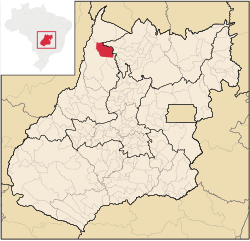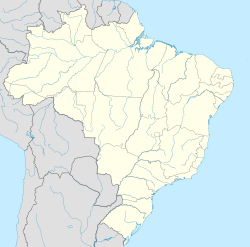Mundo Novo, Goiás
| Mundo Novo | |
|---|---|
| Municipality | |
 Location in Goiás state |
|
| Location in Brazil | |
| Coordinates: 13°46′37″S 50°16′33″W / 13.77694°S 50.27583°WCoordinates: 13°46′37″S 50°16′33″W / 13.77694°S 50.27583°W | |
| Country |
|
| Region | Central-West Region |
| State | Goiás |
| Microregion | São Miguel do Araguaia Microregion |
| Area | |
| • Total | 2,146 km2 (829 sq mi) |
| Elevation | 263 m (863 ft) |
| Population (2007) | |
| • Total | 6,877 |
| • Density | 3.2/km2 (8.3/sq mi) |
| Time zone | BRT/BRST (UTC-3/-2) |
| Postal code | 76530-000 |
Mundo Novo is a municipality in northeastern Goiás state, Brazil.
Mundo Novo is located in the São Miguel do Araguaia Microregion in the extreme north-west of the state. It is cut by the Rio Palmital, which flows north into the Araguaia River. It has road connections with São Miguel—72 kilometers to the north, Nova Crixás—42 kilometers to the south, and Uirapuru—67 kilometers to the southeast.
The distance to the state capital, Goiânia, is 429 km. Highway connections are made by GO-070 / Goianira / Inhumas / Itaberaí / BR-070 / Goiás / GO-164 / Faina / Araguapaz / Nova Crixás / GO-156 for 42 km.
Neighboring municipalities are:
There are several rivers: Rio Palmital, Rio Crixás, and Rio Crixás Mirim, all of them tributaries of the Araguaia River
Novo Mundo began in 1960 on the Nossa Senora Aparecida Ranch owned by Valentim Lourenço, from São Paulo. In 1963 Lourenço divided lots to create a settlement called "Mundo Novo". In 1968 it became a district of Crixás, and was dismembered in 1980.
In January 2005 the Mayor was Maria Beatriz Alves Azambuja and the Vice-mayor was Carlos Osário Lacerda. The city council had 9 members and in 2007 there were 4,692 eligible voters.
In 2007 the population density was 3.20 inhab/km². The urban population was 3,974 and the rural population was 2,903. The population grew quickly from 1991 until 2006. Between 1996 and 2007 the geometric population growth rate was 1.99.%.
The economy is based on cattle raising, agriculture, services, government employment, wood extraction, and modest transformation industries. In 2007 there were 5 industrial establishments and 59 retail establishments. There was one financial institution: BRADESCO S.A. The sectors employing most of the workers (2005) were: public administration with 198 salaried workers, commerce with 106 workers, and agriculture and forestry with 53 workers. In 2007 there were 218 automobiles.
...
Wikipedia

